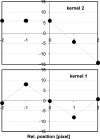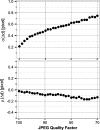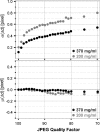Lossy JPEG compression in quantitative angiography: the role of X-ray quantum noise
- PMID: 20169463
- PMCID: PMC3092038
- DOI: 10.1007/s10278-010-9275-8
Lossy JPEG compression in quantitative angiography: the role of X-ray quantum noise
Abstract
In medical imaging, contrary to applications in the consumer market, the use of irreversible or lossy compression is still in its beginnings. This is due to the suspected risk of compromising the diagnostic content. Many studies have been performed, but it was not until 2008 that national activities in different countries resulted in recommendations for the safe use of irreversible image compression in clinical practice. Quantitative coronary angiography (QCA), however, poses a special problem, since here a large variation in published maximum compression factors has strengthened the general concerns about the use of lossy techniques. Up to now, the reason for the variation has not been thoroughly investigated. Reasons for the discrepancies in published compression factors are determined in this study. Since JPEG compression reduces the quantum noise of the X-ray images, the impact of compression is overestimated when interpreting any change in local diameter as an error. By taking into consideration the quantitative effect of quantum noise in QCA, it is shown that the influence of JPEG compression can be neglected for compression factors up to ten at clinically applicable X-ray doses. This limit is comparable to that found by visual analysis for aesthetic image quality. Future studies on image compression effects should take the interaction with quantum noise explicitly into consideration.
Figures







Similar articles
-
Qualitative JPEG 2000 compression in digital mammography - evaluation using 480 mammograms of the CDMAM phantom.Rofo. 2011 Jul;183(7):650-7. doi: 10.1055/s-0031-1273245. Epub 2011 Jun 10. Rofo. 2011. PMID: 21667423
-
Comparison of image compression viability for lossy and lossless JPEG and Wavelet data reduction in coronary angiography.Int J Cardiovasc Imaging. 2001 Feb;17(1):1-12. doi: 10.1023/a:1010644318298. Int J Cardiovasc Imaging. 2001. PMID: 11495503
-
Pan-Canadian evaluation of irreversible compression ratios ("lossy" compression) for development of national guidelines.J Digit Imaging. 2009 Dec;22(6):569-78. doi: 10.1007/s10278-008-9139-7. Epub 2008 Oct 18. J Digit Imaging. 2009. PMID: 18931879 Free PMC article.
-
[Compression of digital images in radiology - results of a consensus conference].Rofo. 2009 Jan;181(1):32-7. doi: 10.1055/s-2008-1027847. Epub 2008 Dec 29. Rofo. 2009. PMID: 19115165 German.
-
Lossy JPEG compression: easy to compress, hard to compare.Dentomaxillofac Radiol. 2006 Mar;35(2):67-73. doi: 10.1259/dmfr/52842661. Dentomaxillofac Radiol. 2006. PMID: 16549431 Review.
Cited by
-
Impact of lossy compression of X-ray projections onto reconstructed tomographic slices.J Synchrotron Radiat. 2020 Sep 1;27(Pt 5):1326-1338. doi: 10.1107/S1600577520007353. Epub 2020 Jul 28. J Synchrotron Radiat. 2020. PMID: 32876608 Free PMC article.
-
"Evaluation of a very low-cost and simple teleradiology technique".J Digit Imaging. 2015 Jun;28(3):295-301. doi: 10.1007/s10278-014-9756-2. J Digit Imaging. 2015. PMID: 25561065 Free PMC article.
References
-
- ISO/IEC 10918 (JPEG) Digital compression and coding of continuous-tone still images.
-
- Seeram E. Irreversible Compression in digital radiology. A literature review. Radiography. 2006;12:45–59. doi: 10.1016/j.radi.2005.04.002. - DOI
-
- Erickson BJ: Irreversible Compression on Medical Images. Society for Computer Applications in Radiology, White Paper, 2000. Available at http://www.scarnet.org/WorkArea/showcontent.aspx?id=1208. Accessed 25 May 2009
-
- Bak PRG. Will the use of Irreversible Compression become a standard of practice? SCAR News. 2006;18(1):10.
MeSH terms
LinkOut - more resources
Full Text Sources

